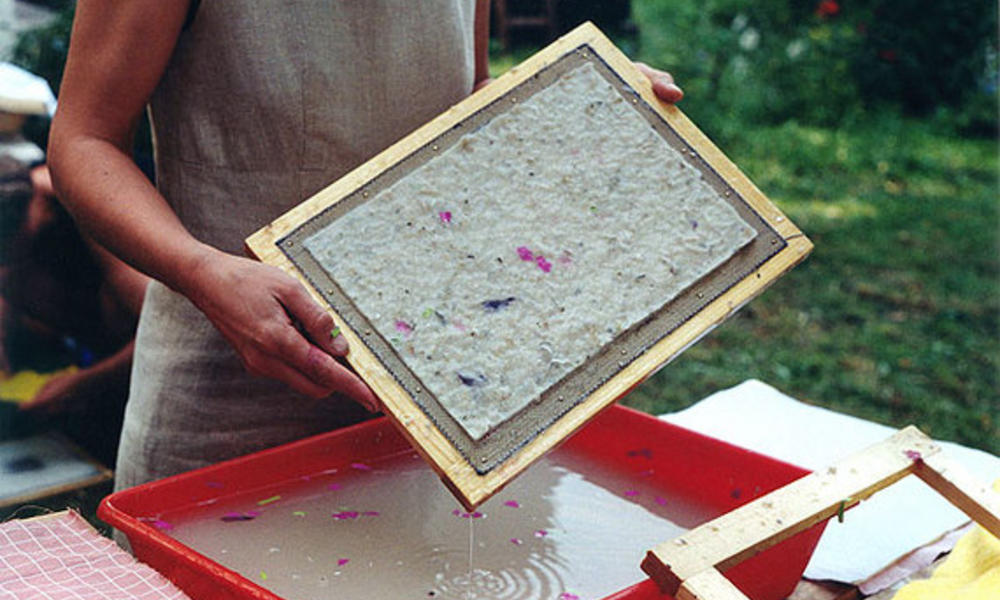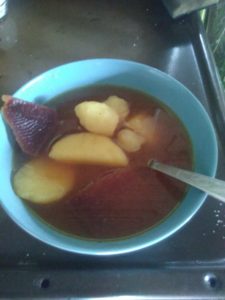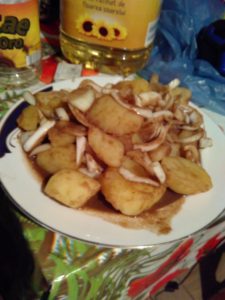A little story about paper – O mică poveste despre hârtie

/EN/
Howdy!
Coming from Germany, I am very used to recycling, especially when it comes to paper. Germans recycle about 80% of all their paper, meanwhile the recycling of paper is nearly non-existent in Romania.
But why go though all the work of carefully selecting the paper and recycling it to new paper? Unlike plastic or metal products, paper is made out of wood which can easily be regrown.
One big reason would be in order to save water. The production of 40g new paper needs 2,8 L of water, compared to 0,2 L for recycling paper. It also becomes a lot more polluted in the process of producing new paper, than in the one for recycled paper. If you are interested in finding out why saving water is so important for the environment, read Robert’s article about water, coming up in the next days.
Another point is, that the chemicals used in order to make paper out of wood are often very toxic and bad for the environment, unlike the ones used for the recycling process. This is especially true for the bleaching of newly made paper, which is either not done with recycling paper or done with non-toxic chemicals.
The recycling process for paper also needs 1/3 of the energy of producing newly made paper.
It also needs wood. While trees can be regrown, it takes years for them to do so and if we use up to much wood to regrow, the amount of forests in a country decrease and decrease, as is currently the case in Romania.
If you want to help the environment, try to sort paper and put it into the blue recycling bin, buy recycling paper instead of normal one and use both sides of paper.
And here is a little guide for recycling paper yourself:
- Put small pieces of paper [tear them apart by hand] into a bucket of water and leave it alone for three days
- Nail a fly screen onto a wooden frame (about the size of a piece of paper)
- Blend the water-paper-mix with a blender. If the mass is to solid, add warm water.
- Put the paper-mix into a big container, add water (About a quater of the paper mass). Take the frame from step 2 and pull it slowly though the water, till their is a small layer of paper on it.z
- Tear the layer slowly from the frame and leave it to dry
/RO/
Servus!
Venind din Germania sunt obișnuită să reciclez, mai ales hârtie. Nemții reciclează în jur de 80% din hârtie, în timp ce reciclarea hârtiei în România e aproape inexistentă.
Dar de ce să trecem prin acest proces de selectare a hârtiei și reciclare? Spre deosebire de plastic și metal, hârtia e făcută din lemn, care poate fi înlocuit prin plantare.
Un motiv important pentru a recicla este pentru a economisi apă. Pentru a produce 40gr de hârtie nouă e nevoie de 2.8L apă, în timp ce pentru aceeași cantitate prin reciclare e nevoie de 0.2L. De asemenea apa devine mai poluată la finalul acestui proces, decât cea folosită la reciclare. Dacă vreți să aflați mai multe despre importanța apei pentru mediu, citiți articolul lui Robert (urmează în următoarele zile, fiți pe faza).
Un alt motiv ar fi chimicalele folosite pentru a crea hârtie, care sunt adesea toxice și nocive pentru mediu, spre deoasebire de cele pentru reciclare. Asta mai ales din cauza înălbitorilor folosiți pentru hârtie, care nu sunt folosiți la hârtia reciclată, ori sunt folosiți unii non-toxici.
În plus, procesul de reciclare a hârtiei are nevoie de doar o treime din energia folosită pentru hârtia nouă. Apoi mai are nevoie de lemn. Chiar dacă pădurile pot refăcute, durează ani de zile pentru acest lucru, iar dacă folosim pădurile prea mult, zonele împădurite scad vizibil, cum e cazul României.
Dacă vrei să ajuți mediul, încearcă să sortezi hârtia și pune-o în containerul albastru, cumpără hârtie reciclată în loc de cea obișnuită și mai ales folosește ambele părți ale hârtiei.
Aici aveți un mic ghid de reciclare a hârtiei:
- Pune bucățele de hârtie (rupte cu mâna) într-o găleată cu apă și lasă-le trei zile.
- Prinde o pânză de țânțari pe o ramă de lemn (de mărimea hârtiei pe care vei să o produci)
- Amestecă compoziția de hârtie cu apă cu un blender. Dacă e prea tare, mai pune puțină apă caldă.
- Transferă amestecul într-un vas mai mare și mai pune apă (un sfert din cantitatea de hârtie). Ia rama de la punctul 2 și trece-o ușor prin apă, până ai un mic strat de hârtie pe ea.
- Desfă stratul ușor de pe ramă și lasă-l să se usuce.
Milena este în România pentru o perioadă de cinci luni, din iulie 2018 până în noiembrie 2018, în cadrul proiectului Building Youth supportive Communities – Environment [2017-2-RO01-KA105-037748] proiect cofinanțat de Uniunea Europeană prin Programul Erasmus+ și implementat în România de către Curba de Cultură.
Conscious cooking / Gătit conștient
/EN/ We all cause harm to the environment, just by being alive. Which is only more of a reason to try cutting down on it, for ourselves and the next generations. One area where that is very easy, but also necessary is our nourishment. The industrial agriculture is responsible for 18 % of all emissions and one of the biggest reasons for the deforestation of the Tropical Forests . Animal products are especially bad. In order to produce one kilo of meat, one must first invest 7-16 kilo of wheat or soy, soy that comes more often than not from fields that were previously the Brazilian rain forest. Another big cause of harm is the import of food products from other countries or sometimes even continents. They have to first cross the oceans and then be transported hundreds of kilometers in trucks to get to your local super market. Transports that cause tons of CO2 emissions to be pumped into the atmosphere.
I very much try to abide to these ideas while cooking. One of my favourite meals that does exactly that is Red Beet Soup. It’s a polish meal and I cook it after my mother’s recipe. While I never managed to make it quiet as good as she does, I still love cooking (and eating) it.
Ingredients:

- 1 red beet
- 3 big potatoes
- 1 carrot
- a cube of vegetable stock
- a bit of salt
You first peel the red beet, carrot and potatoes and cut them into small cubes.
Then cook the vegetables in water, till they are tender. While they are cooking add the cube of vegetable stock and a bit of salt.
Tipp: The soup tastes even better if you let it stand for a few hours and then rewarm it.
Another rather easy, but delicious recipe my mother thaught me, is her Southern German style potato salad. It is perfect as a side dish or appetizer.
- 1 big onion
- 1/2 big spoon sweet mustard

- 4 big potatoes
- 3 big spoons vinegar
- one cube of vegetable stock
- a bit of salt
Peel and cut the potatoes into big cubes. Cook them till they are tender. In the meanwhile cut the onions into pieces. Put half a glass of boiling water over the vegetable stock cube and mix it. Afterwards mix it with the vinegar, the mustard and the salt. Put the cooked potatoes, the mix and the onions into a big bowl and mix everything. Then put into the fridge for an hour.
/RO/ Cu toții cauzăm daune mediului înconjurător, pur și simplu prin a trăi. Ceea ce este doar un motiv în plus să încercăm să tăiem din asta, pentru noi și pentru generațiile viitoare. O zonă unde asta este foarte ușor, dar de asemenea necesar este hrănirea noastră. Agricultura industrială e responsabilă pentru 18 % din toate emisiile și unul dintre cele mai mari motive pentru deforestizarea Pădurilor Tropicale. Produsele animale sunt rele în mod special. Pentru a produce un kilogram de carne, trebuie investite 7-16 kilograme de grâu sau soia, soia care de cele mai multe ori vine din câmpuri care obișnuiau să fie Pădurea Tropicală Braziliană. O altă mare cauză de nocivitatea este importul de produse alimentare din alte țări sau uneori chiar alte continente. Trebuie întâi să treacă oceanele și apoi să fie transportate sute de kilometri în camioane pentru a ajunge la supermarket-ul vostru local. Transporturi care cauzează tone emisii de CO2 să fie pompate în atmosferă.
Încerc foarte mult să mă țin de aceste idei în timp ce gătesc. Una dintre mâncărurile mele favorite care face exact asta este Supa de Sfeclă Roșie. Este un preparat polonez și îl gătesc după rețetă mamei mele. Deși nu reușesc să o fac chiar așa de bună cum o face ea, tot iubesc să o gătesc (și să o mănânc).
Ingrediente:

- 1 sfeclă roșie
- 3 cartofi mari
- 1 morcov
- un cub de vegetable stock
- puțină sare
Pentru început curățați sfecla roșie, morcovii și cartofii și le tăiați în cuburi mici.
Apoi gătiți legumele în apă, până sunt fragede. În timp ce se gătesc adăugați cubul de stock de legume și puțină sare.
Pont: Supa are un gust chiar și mai bun dacă o lași să stea pentru câteva ore și apoi o reîncălzești.
O altă destul de ușoară, dar delicioasă rețetă pe care mama mea m-a învățat-o, este salata ei de cartofi în stil Sudic German. Este perfectă ca și garnitură sau aperitiv.
- 1 ceapă mare
- 1/2 lingură mare de muștar dulce

- 4 cartofi mari
- 3 linguri mari de oțet
- un cub de vegetable stock
- puțină sare
Curățați și tăiați cartofii în cuburi mari. Gătiții până sunt fragezi. Între timp tăiați ceapa în bucăți. Puneți jumătate de pahar de apă clocotită peste cubul de vegetable stock și amestecați. După aceea amestecați-l cu oțetul, muștarul și cu sarea. Puneți cartofii gătiți, mixul și ceapa într-un bol mare și amestecați totul. Apoi puneți în frigider pentru o oră.
Portret de voluntar – Milena (Germania)
 Salut! I arrived in this beautiful little village just a few days ago. I drove all the way from my small rural village on the edge of the Danube valley, Southern Germany, to Izvoarele by car. The way the landscape, town and cities changed on the way was amazing. On the end of my journey I was greeted by a place so different, but also in some ways similar to the place I called home my whole life.
Salut! I arrived in this beautiful little village just a few days ago. I drove all the way from my small rural village on the edge of the Danube valley, Southern Germany, to Izvoarele by car. The way the landscape, town and cities changed on the way was amazing. On the end of my journey I was greeted by a place so different, but also in some ways similar to the place I called home my whole life.
I was amazed by all the animals everywhere, which just ran around instead of being carefully confined like in my home region, may it be dogs, cows, horses or sheep. The horse carriages made me feel like I traveled back in time, as I had only ever seen them as tourist traps in major cities or for traditional festivals before.
I was also happy to notice, that despite having been told that this was an agricultural region. The forests were rather preserved and land used for agricultural usage was small and in-between; at least compared to my home region, where strips of trees where rare between all the big cultivated fields. The view was just breathtaking. Despite all this there was trash laying around everywhere and in that moment I knew, that my project, to promote environmental conscious waste management, was important.
When I finally arrived in Curba de Cultura I was welcomed by the other volunteers with an elan and joy that made me feel home right away. The first day was kinda confusing, thanks to a mix of being tired because of the long drive and the mountain of information I had to process. But I quickly settled in the next few days and had a lot of fun. I hope the next few months will be as great as the few days I had till now.
Salut! Am ajuns în acest frumos sat acu câteva zile. Am condus din sătucul meu, de unde începe Dunărea, din sudul Germaniei până în Izvoarele. Modul în care peisajele și orașele s-au schimbat a fost uimitor. La finalul călătoriei mele am fost întâmpinată de un loc atât de diferit și totuși similar cu locul pe care îl numesc acasă.
M-au mirat animalele care se găsesc peste tot, care aleargă și nu sunt îngrădite precum în regiunea mea natală, fiecă că vorbim de câini, vaci, cai sau oi. Căruțele m-au făcut să mă simt ca și cum aș fi călătorit înapoi în timp, căci singurele ocazii când le-am văzut au fost când au fost folosite ca capcane pentru turiști în orașe și festivaluri tradiționale.
M-am bucurat să constat, cu toate că mi-a fost spus, că aceasta este o zonă destul de agricolă. Pădurile par păstrate, iar terenul folosit pentru agricultură este în bucăți mici și printre păduri; cel puțin în comparație cu regiunea mea unde zonele cu copaci sunt rare printre zonele cultivate. Imaginea îți taie răsuflarea. Cu toate acestea am văzut gunoi peste tot și am știut că proiectul pentru care vin este important.
Când am ajuns în cele din urmă la Curba de Cultură am fost primită de ceilalți voluntari cu un elan și o bucurie care m-a făcut să mă simt acasă. Prima zi a fost puțin confuză din cauza unui amestec de oboseală după condus un drum lung și un munte de informații pe care a trebuit să le procesez. Dar în zilele următoare toate s-au aranjat și m-am distrat bine. Sper ca și lunile următoare să fie la fel.
Milena este în România pentru o perioadă de cinci luni, din iulie 2018 până în noiembrie 2018, în cadrul proiectului Building Youth supportive Communities – Environment [2017-2-RO01-KA105-037748] proiect co-finanțat de Uniunea Europeană prin Programul Erasmus+ și implementat în România de către Curba de Cultură.